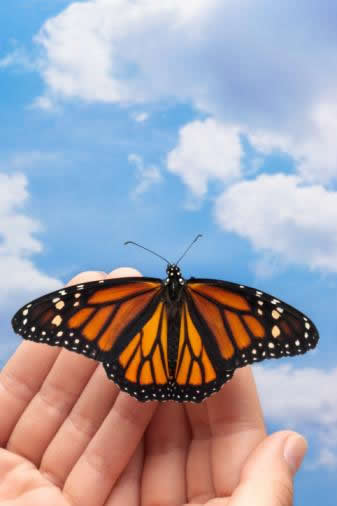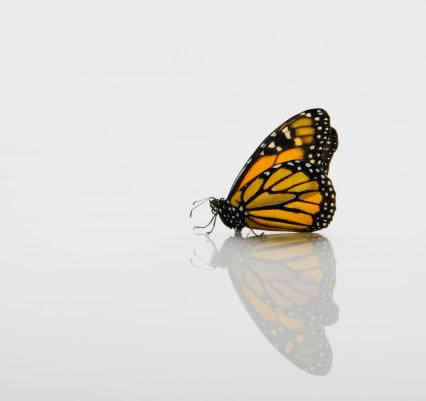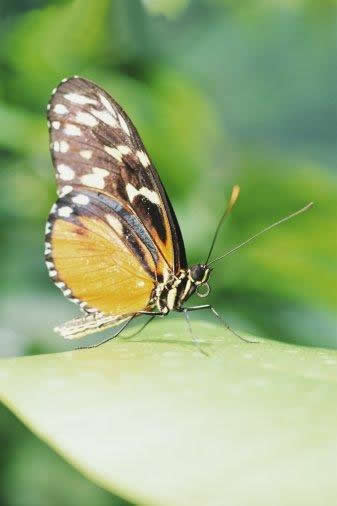CityU Web Hacker - Butterfly

Etymology
The Old English word for butterfly was buttorfleoge apparently because butterflies were thought to steal milk. A similar word occurs in Dutch and German originating from the same belief. This is believed to have led to the evolution of its present name form - butterfly.
An alternative folk etymology, current in Great Britain, is that it originated as a contraction of term butter-coloured fly referring to the Brimstone Butterfly Gonepteryx rhamni, often the first butterfly of Spring. Earlier, it was mistakenly considered that the word butterfly came from a metathesis of "flutterby".
Classification
Presently butterflies are classified in two superfamilies, Hesperioidea, consisting of the 'skippers' and Papilionoidea or 'true butterflies'. These are sister taxa, so the butterflies collectively are thought to constitute a true clade. Some modern taxonomists place them all in superfamily Papilionoidea, distinguishing the skippers from the other butterflies at the series level only. In this system, Papilionoidea consists of the series Hesperiiformes (with one family only, the skipper family Hesperiidae) and the series Papilioniformes (with five families).
Butterfly families
The five families of true butterflies usually recognized in the Papilionoidea are:-
- Family Papilionidae, the Swallowtails and Birdwings
- Family Pieridae, the Whites and Yellows
- Family Lycaenidae, the Blues and Coppers, also called the Gossamer-Winged Butterflies
- Family Riodinidae, the Metalmark butterflies
- Family Nymphalidae, the Brush-footed butterflies
Some common/well known butterfly species
There are between 15,000 and 20,000 species of butterflies worldwide. Some well known species from around the world include:
- Swallowtails and Birdwings, Family Papilionidae
- Common Yellow Swallowtail, Papilio machaon
- Spicebush Swallowtail, Papilio troilus
- Lime Butterfly, Papilio demoleus
- Ornithoptera genus (Birdwings; the largest butterflies)
- Whites or Yellows, Family Pieridae
- Small White, Pieris rapae
- Green-veined White, Pieris napi
- Common Jezebel, Delias eucharis
- Blues and Coppers or Gossamer-Winged Butterflies, Family Lycaenidae
- Xerces Blue, Glaucopsyche xerces
- Karner Blue, Lycaeides melissa samuelis (endangered)
- Red Pierrot, Talicada nyseus
- Metalmark butterflies, Family Riodinidae
- Lange's Metalmark Butterfly
- Plum Judy, Abisara echerius
- Brush-footed butterflies, Family Nymphalidae
- Painted Lady, or Cosmopolite, Vanessa cardui
- Monarch butterfly, Danaus plexippus
- Morpho genus
- Speckled Wood, Pararge aegeria

Difference between butterflies and moths
Butterflies and moths are often confused with each other. Although there are many ways of distinguishing a butterfly from a moth, there are exceptions to every rule, and it is perhaps better to think of butterflies as a group of day flying moths.
Taxonomic issues
A major new study (Wahlberg et al., 2005) combining morphological and molecular data concluded that Hesperiidae, Papilionidae, Pieridae, Lycaenidae and Riodinidae could all be strongly supported as monophyletic groups, but the status of Nymphalidae is equivocal. Lycaenidae and Riodinidae were confirmed as sister taxa, and Papilionidae as the outgroup to the rest of the true butterflies, but the location of Pieridae within the pattern of descent was unclear, with different lines of evidence suggesting different conclusions. The data suggested that the moths of Hedyloidea are indeed more closely related to the butterflies than to other moths.
Some older classifications recognize additional families, for example Danaidae, Heliconiidae, Libytheidae and Satyridae, but modern classifications treat these as subfamilies within the Nymphalidae.
The four stages in the lifecycle of a butterfly
Unlike many insects, butterflies do not experience a nymph period, but instead go through a pupal stage which lies between the larva and the adult stage (the imago).
- Egg
- Larva, known as a caterpillar
- Pupa (chrysalis)
- Adult butterfly (imago)
Egg
Butterfly eggs consist of a hard-ridged outer layer of shell, called the chorion. This is lined with a thin coating of wax which prevents the egg from drying out before the larva has had time to fully develop. Each egg contains a number of tiny funnel-shaped openings at one end, called micropyles; the purpose of these holes is to allow sperm to enter and fertilize the egg. Butterfly and moth eggs vary greatly in size between species, but they are all either spherical or ovate.
Butterfly eggs are fixed to a leaf with a special glue which hardens rapidly. As it hardens it contracts deforming the shape of the egg. This glue is easily seen surrounding the base of every egg forming a meniscus. The nature of the glue is unknown, and is a suitable subject for research. The same glue is produced by a pupa to secure the setae of the cremaster. This glue is so hard that the silk pad, to which the setae are glued, cannot be separated.
Caterpillars
Larvae, or caterpillars, are multi-legged eating machines. They consume plant leaves and spend practically all of their time in search of food.
Caterpillars mature through a series of stages, called instars. Near the end of each instar, the larva undergoes a process called apolysis, in which the cuticle, a mixture of chitin and specialized proteins, is released from the epidermis and the epidermis begins to form a new cuticle beneath. At the end of each instar, the larva moults the old cuticle, and the new cuticle rapidly hardens and pigments. Development of butterfly wing patterns begins by the last larval instar.
Wing development in larval stage

Last instar wing disk, Junonia coeniaButterflies belong to the specialized and prolific lineage of holometabolous insects, which means that wings or wing pads are not visible on the outside of the larva, but when larvae are dissected, tiny developing "wing disks" can be found on the second and third thoracic segments, in place of the spiracles that are apparent on abdominal segments.
Wing disks develop in association with a trachea that runs along the base of the wing, and are surrounded by a thin "peripodial membrane", which is linked to the outer epidermis of the larva by a tiny duct.
Wing disks are very small until the last larval instar, when they increase dramatically in size, are invaded by branching tracheae from the wing base that precede the formation of the wing veins, and begin to express molecular markers in patterns associated with several landmarks of the wing.
Near pupation, the wings are forced outside the epidermis under pressure from the hemolymph, and although they are initially quite flexible and fragile, by the time the pupa breaks free of the larval cuticle they have adhered tightly to the outer cuticle of the pupa (in obtect pupae). Within hours, the wings form a cuticle so hard and well-joined to the body that pupae can be picked up and handled without damage to the wings.
Pupa
When the larva exceeds a minimum weight at a particular time of day, it will stop feeding and begin "wandering" in a quest for a suitable pupation site, usually the underside of a leaf. The larva transforms into a pupa (chrysalis), which then transforms into a butterfly by metamorphosis. To transform from the miniature wings visible on the outside of the pupa into large structures usable for flight, the pupal wings undergo rapid mitosis and absorb a great deal of nutrients. If one wing is surgically removed early on, the other three will grow to a larger size. In the pupa, the wing forms a structure that becomes compressed from top to bottom and pleated from proximal to distal ends as it grows, so that it can rapidly be unfolded to its full adult size. Several boundaries seen in the adult color pattern are marked by changes in the expression of particular transcription factors in the early pupa.
Adult Butterfly or Imago
The adult, sexually mature, stage of the insect is known as the imago. As Lepidoptera, butterflies have four wings that are covered with tiny scales, but, unlike moths, the fore- and hindwings are not hooked together, permitting a more graceful flight. A butterfly has six legs; the larva also has six true legs and a number of prolegs. After it emerges from its pupal stage, it cannot fly for some time, because its wings have not yet unfolded. A newly-emerged butterfly needs to spend some time 'inflating' its wings with blood and letting them dry, during which time it is extremely vulnerable to predators.
 Cityu web hacker - Butterfly
Cityu web hacker - Butterfly